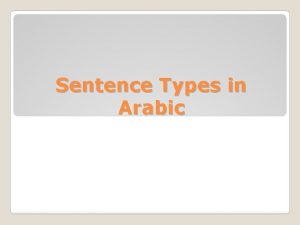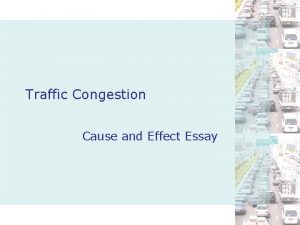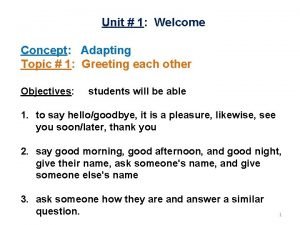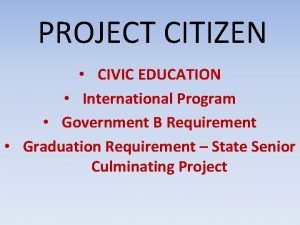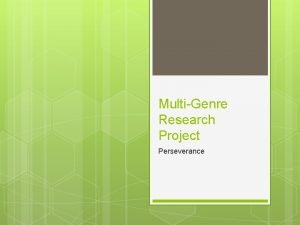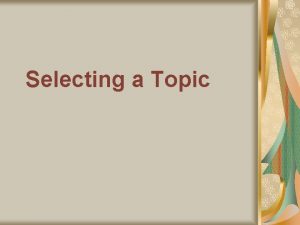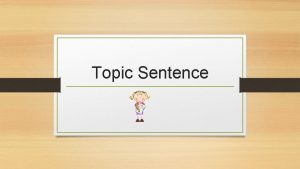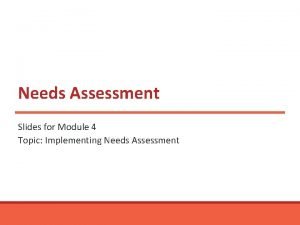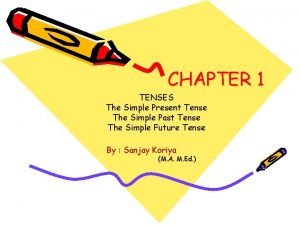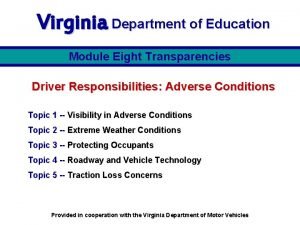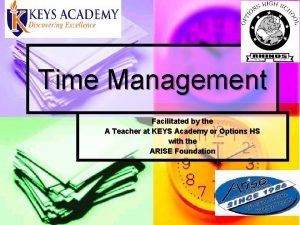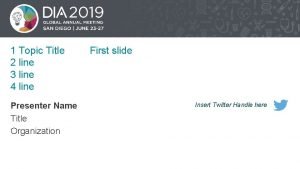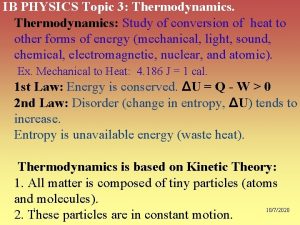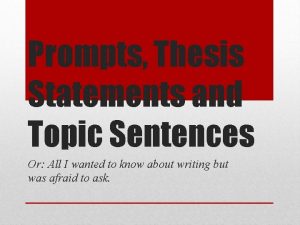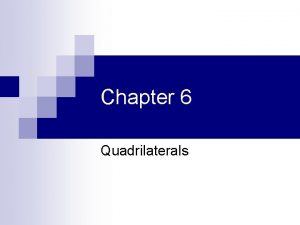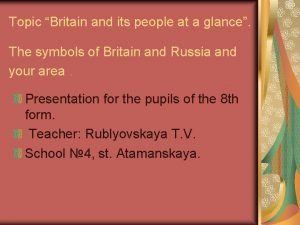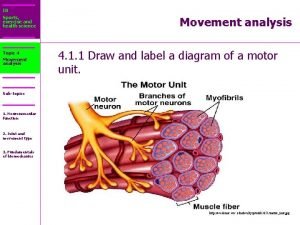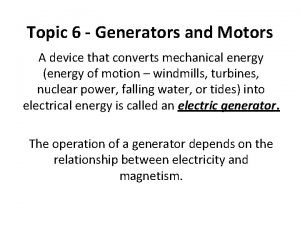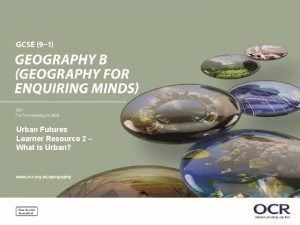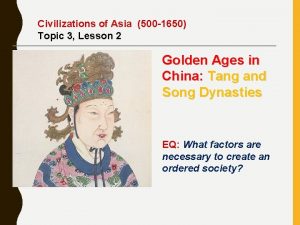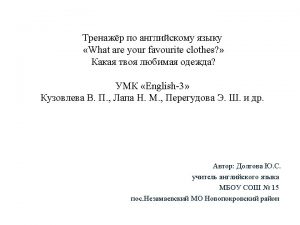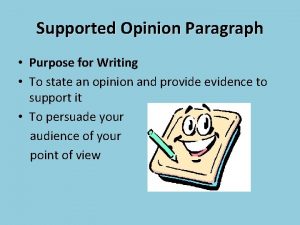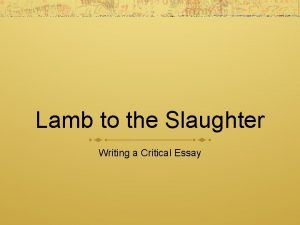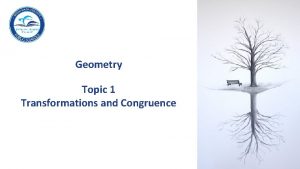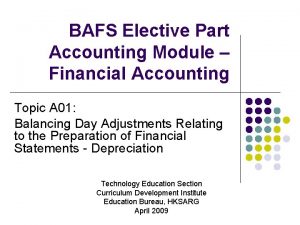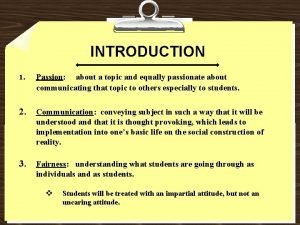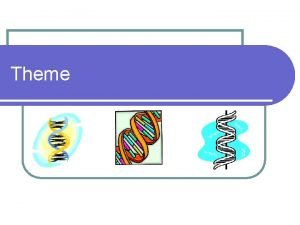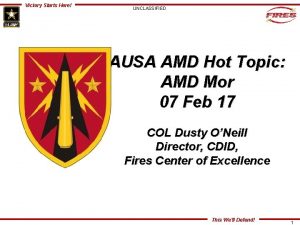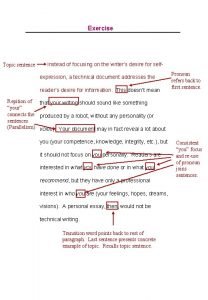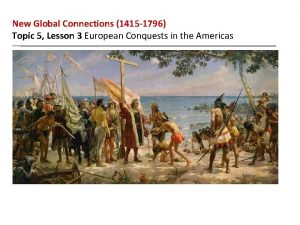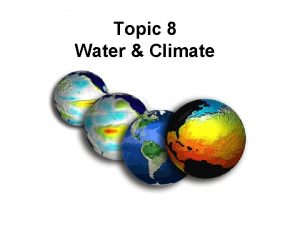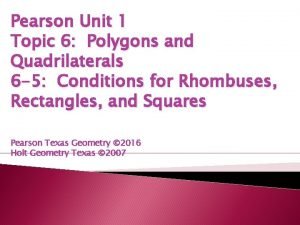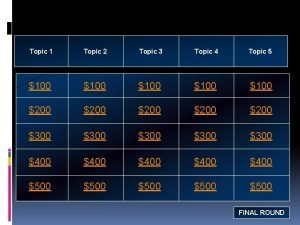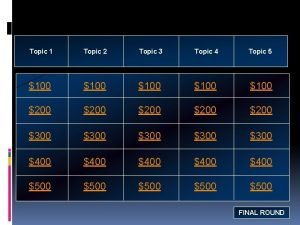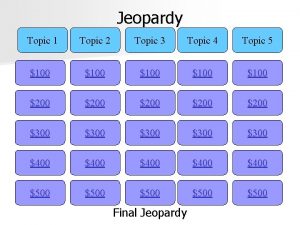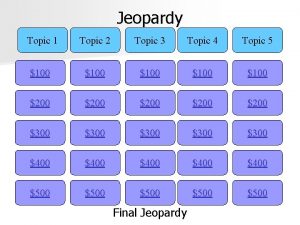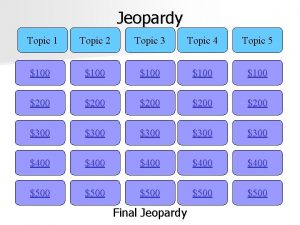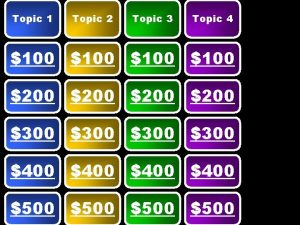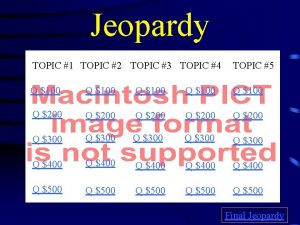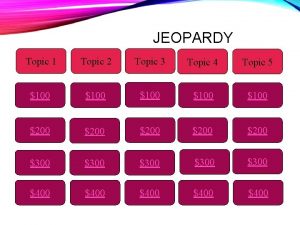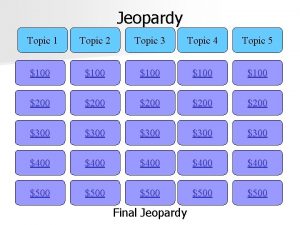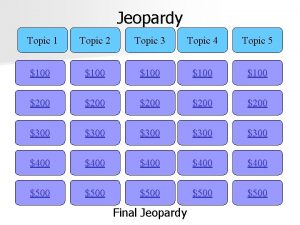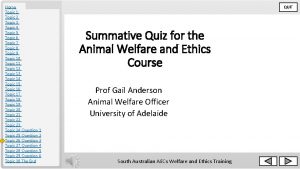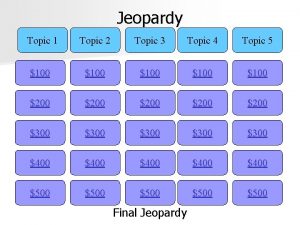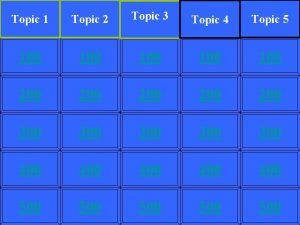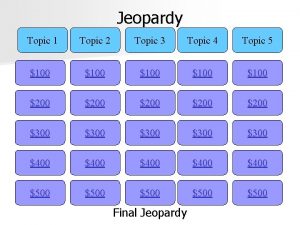Topic 1 Topic 2 Topic 3 Topic 4





















































- Slides: 53

Topic 1 Topic 2 Topic 3 Topic 4 Topic 5 $100 $100 $200 $200 $300 $300 $400 $400 $500 $500 FINAL ROUND

Topic 1: $100 Question: The spleen is an organ most closely associated with the ____ system: a. Lymphatic b. Reproductive c. Nervous d. Urinary e. Muscular ANSWER BACK TO GAME

Topic 1: $100 Answer Question: The spleen is an organ most closely associated with the ____ system: a. Lymphatic b. Reproductive c. Nervous d. Urinary e. Muscular BACK TO GAME

Topic 1: $200 Question: Which of the following connect to the lymph node at the hilus: a. Trabecula b. Subscapular sinus c. Medullary sinus d. Afferent lymphatic vessels e. Efferent lymphatic vessels ANSWER BACK TO GAME

Topic 1: $200 Answer Question: Which of the following connect to the lymph node at the hilus: a. Trabecula b. Subscapular sinus c. Medullary sinus d. Afferent lymphatic vessels e. Efferent lymphatic vessels BACK TO GAME

Topic 1: $300 Question: Which of the following antibody classes is usually arranged as a pentamer: a. Ig. G b. Ig. A c. Ig. M d. Ig. D e. Ig. E ANSWER BACK TO GAME

Topic 1: $300 Answer Question: Which of the following antibody classes is usually arranged as a pentamer: a. Ig. G b. Ig. A c. Ig. M d. Ig. D e. Ig. E BACK TO GAME

Topic 1: $400 Question: Which of the letter(s) on this diagram represent light chain structure: a. D only b. C and D c. C only d. A and B e. A and D ANSWER BACK TO GAME

Topic 1: $400 Answer Question: Which of the letter(s) on this diagram represent light chain structure: a. D only b. C and D c. C only d. A and B e. A and D BACK TO GAME

Topic 1: $500 Question: What does this computer generated image represent: a. Hemoglobin b. Antibody c. Testosterone d. Nephron e. Estrogen ANSWER BACK TO GAME

Topic 1: $500 Answer Question: What does this computer generated image represent: a. Hemoglobin b. Antibody c. Testosterone d. Nephron e. Estrogen BACK TO GAME

Topic 2: $100 Question: Letter “D” most likely represents: a. Tracheal cap b. Larynx c. Epiglottis d. Bronchial cap e. Pharynx ANSWER BACK TO GAME

Topic 2: $100 Answer Question: Letter “D” most likely represents: a. Tracheal cap b. Larynx c. Epiglottis d. Bronchial cap e. Pharynx BACK TO GAME

Topic 2: $200 Question: When you exhale, air flows through respiratory structures in which sequence: a. alveolus, bronchiole, bronchus, larynx, trachea, pharynx, nasal cavity b. alveolus, trachea, bronchus, bronchiole, pharynx, larynx, oral cavity c. alveolus, bronchiole, bronchus, trachea, larynx, pharynx, nasal cavity d. alveolus, bronchus, trachea, bronchiole, pharynx, larynx, nasal cavity e. alveolus, bronchiole, trachea, larynx, pharynx, nasal cavity ANSWER BACK TO GAME

Topic 2: $200 Answer Question: When you exhale, air flows through respiratory structures in which sequence: a. alveolus, bronchiole, bronchus, larynx, trachea, pharynx, nasal cavity b. alveolus, trachea, bronchus, bronchiole, pharynx, larynx, oral cavity c. alveolus, bronchiole, bronchus, trachea, larynx, pharynx, nasal cavity d. alveolus, bronchus, trachea, bronchiole, pharynx, larynx, nasal cavity e. alveolus, bronchiole, trachea, larynx, pharynx, nasal cavity BACK TO GAME

Topic 2: $300 Question: When you inhale, the diaphragm: a. Contracts and moves inferiorly b. Relaxes and moves inferiorly c. Contracts and moves superiorly d. Relaxes and moves superiorly e. Depresses you lungs superiorly ANSWER BACK TO GAME

Topic 2: $300 Answer Question: When you inhale, the diaphragm: a. Contracts and moves inferiorly b. Relaxes and moves inferiorly c. Contracts and moves superiorly d. Relaxes and moves superiorly e. Depresses you lungs superiorly BACK TO GAME

Topic 2: $400 Question: Which primary bronchus is the more likely site for an inspired object to become lodged? Why? a. The left primary bronchus. Because it is straighter and smaller in diameter. b. The left primary bronchus. Because it is straighter and larger in diameter. c. The right primary bronchus. Because it is straighter and smaller in diameter. d. The right primary bronchus. Because it is straighter and larger in diameter. e. The left primary bronchus. Because it is slightly bent, allowing obstruction. ANSWER BACK TO GAME

Topic 2: $400 Answer Question: Which primary bronchus is the more likely site for an inspired object to become lodged? Why? a. The left primary bronchus. Because it is straighter and smaller in diameter. b. The left primary bronchus. Because it is straighter and larger in diameter. c. The right primary bronchus. Because it is straighter and smaller in diameter. d. The right primary bronchus. Because it is straighter and larger in diameter. e. The left primary bronchus. Because it is slightly bent, allowing obstruction. BACK TO GAME

Topic 2: $500 Question: Which of the following represents the largest value: a. VC b. TV c. IRV d. ERV e. IC ANSWER BACK TO GAME

Topic 2: $500 Answer Question: Which of the following represents the largest value: a. VC b. TV c. IRV d. ERV e. IC BACK TO GAME

Topic 3: $100 Question: A digestive organ that is not part of the alimentary canal: a. Stomach b. Small intestine c. Pharynx d. Large intestine e. Liver ANSWER BACK TO GAME

Topic 3: $100 Answer Question: A digestive organ that is not part of the alimentary canal: a. Stomach b. Small intestine c. Pharynx d. Large intestine e. Liver BACK TO GAME

Topic 3: $200 Question: The closure of which valve is assisted by the diaphragm: a. Ileocecal valve b. Pyloric valve c. Cardioesophageal valve d. Fundal valve e. Pnemofundal valve ANSWER BACK TO GAME

Topic 3: $200 Answer Question: The closure of which valve is assisted by the diaphragm: a. Ileocecal valve b. Pyloric valve c. Cardioesophageal valve d. Fundal valve e. Pnemofundal valve BACK TO GAME

Topic 3: $300 Question: The p. H of chyme entering the duodenum is adjusted by: a. Bile b. Bicarbonate-rich secretions from the pancreas c. Brush border enzymes d. Enzyme secretions from the pancreas e. Intestinal juice ANSWER BACK TO GAME

Topic 3: $300 Answer Question: The p. H of chyme entering the duodenum is adjusted by: a. Bile b. Bicarbonate-rich secretions from the pancreas c. Brush border enzymes d. Enzyme secretions from the pancreas e. Intestinal juice BACK TO GAME

Topic 3: $400 Question: Which of the following refers to the action of swallowing: a. Aglutination b. Mastication c. Peristalsis d. Deglutination e. Regurgitation ANSWER BACK TO GAME

Topic 3: $400 Answer Question: Which of the following refers to the action of swallowing: a. Aglutination b. Mastication c. Peristalsis d. Deglutination e. Regurgitation BACK TO GAME

Topic 3: $500 Question: Number “ 4” represents: a. Plicae circulares b. Common hepatic duct c. Cystic duct d. Hepatic artery e. Hepatic duct ANSWER BACK TO GAME

Topic 3: $500 Answer Question: Number “ 4” represents: a. Plicae circulares b. Common hepatic duct c. Cystic duct d. Hepatic artery e. Hepatic duct BACK TO GAME

Topic 4: $100 Question: The material that forms the bulk of a tooth is: a. Enamel b. Cementation c. Bone d. Pulp e. Dentin ANSWER BACK TO GAME

Topic 4: $100 Answer Question: The material that forms the bulk of a tooth is: a. Enamel b. Cementation c. Bone d. Pulp e. Dentin BACK TO GAME

Topic 4: $200 Question: Complete this statement: In glycolysis _______ is oxidized and ____ is reduced. a. glucose; oxygen b. glucose; vitamin-containing coenzyme c. ATP; ADP d. vitamin-containing coenzyme; glucose e. glycogen; glucose ANSWER BACK TO GAME

Topic 4: $200 Answer Question: Complete this statement: In glycolysis _______ is oxidized and ____ is reduced. a. glucose; oxygen b. glucose; vitamin-containing coenzyme c. ATP; ADP d. vitamin-containing coenzyme; glucose e. glycogen; glucose BACK TO GAME

Topic 4: $300 Question: Where in the stomach do the strongest peristaltic waves occur? a. Longitudinal layer b. Cardiac region c. Fundus d. Pylorus e. Circular layer ANSWER BACK TO GAME

Topic 4: $300 Answer Question: Where in the stomach do the strongest peristaltic waves occur? a. Longitudinal layer b. Cardiac region c. Fundus d. Pylorus e. Circular layer BACK TO GAME

Topic 4: $400 Question: Only one organ produces enzymes capable of digesting all groups of foodstuffs. What organ is this? a. Liver b. Spleen c. Pancreas d. Small intestine e. Stomach ANSWER BACK TO GAME

Topic 4: $400 Answer Question: Only one organ produces enzymes capable of digesting all groups of foodstuffs. What organ is this? a. Liver b. Spleen c. Pancreas d. Small intestine e. Stomach BACK TO GAME

Topic 4: $500 Question: Microscopic examination of a secretion of the kidney shows a thick-walled vessel with glomeruli scattered in the tissue on one side of the vessel but not on the other side. What vessel is this? a. Arcuate vein b. Interglobular artery c. Interglobular vein d. Arcuate artery e. Glomerular artery ANSWER BACK TO GAME

Topic 4: $500 Answer Question: Microscopic examination of a secretion of the kidney shows a thick-walled vessel with glomeruli scattered in the tissue on one side of the vessel but not on the other side. What vessel is this? a. Arcuate vein b. Interglobular artery c. Interglobular vein d. Arcuate artery e. Glomerular artery BACK TO GAME

Topic 5: $100 Question: Which is a normal value for percent of body weight that is water for a person of old age? a. 70% b. 65% c. 50% d. 45% e. 40% ANSWER BACK TO GAME

Topic 5: $100 Answer Question: Which is a normal value for percent of body weight that is water for a person of old age? a. 70% b. 65% c. 50% d. 45% e. 40% BACK TO GAME

Topic 5: $200 Question: What is the glomerulus? a. Renal tubules b. Bowman’s capsule c. Nephron d. Capillaries e. Organ of the male ANSWER BACK TO GAME

Topic 5: $200 Answer Question: What is the glomerulus? a. Renal tubules b. Bowman’s capsule c. Nephron d. Capillaries e. Organ of the male BACK TO GAME

Topic 5: $300 Question: Urine passes through the ureters by which mechanism? a. Nephrons b. Uric acid c. Muscles in the urinary bladder d. Peristalsis e. Irritability ANSWER BACK TO GAME

Topic 5: $300 Answer Question: Urine passes through the ureters by which mechanism? a. Nephrons b. Uric acid c. Muscles in the urinary bladder d. Peristalsis e. Irritability BACK TO GAME

Topic 5: $400 Question: Which of these is mismatched? a. Vagina - penis b. Testis - ovary c. Oviduct – ductus deferens d. Rete testis – rete ovary e. Labia majora - scrotum ANSWER BACK TO GAME

Topic 5: $400 Answer Question: Which of these is mismatched? a. Vagina - penis b. Testis - ovary c. Oviduct – ductus deferens d. Rete testis – rete ovary e. Labia majora - scrotum BACK TO GAME

Topic 5: $500 Question: Human ova and sperm are similar in that: a. They are about the same size b. About the same number of each is produced per month c. They have the same number of chromosomes d. They have the same degree of mobility e. Each produce about the same number of mitochondria ANSWER BACK TO GAME

Topic 5: $500 Answer Question: Human ova and sperm are similar in that: a. They are about the same size b. About the same number of each is produced per month c. They have the same number of chromosomes d. They have the same degree of mobility e. Each produce about the same number of mitochondria BACK TO GAME

FINAL ROUND Question: a. Choice 1 b. Choice 2 c. Choice 3 d. Choice 4 ANSWER BACK TO GAME

FINAL ROUND Answer Question: a. Choice 1 b. Choice 2 c. Choice 3 (correct answer) d. Choice 4 BACK TO GAME
 Clueing topic sentence
Clueing topic sentence /topic/ down
/topic/ down In arabic language
In arabic language Cause and effect introduction
Cause and effect introduction Topic 1
Topic 1 Project citizen ideas
Project citizen ideas Multigenre research project examples
Multigenre research project examples Ib computer science topic 1 questions
Ib computer science topic 1 questions Choose only one topic
Choose only one topic Topic sentence adalah
Topic sentence adalah Topic specific pagerank
Topic specific pagerank Module 4 topic 1
Module 4 topic 1 S es rules in simple present tense
S es rules in simple present tense Contoh single topic region
Contoh single topic region Organic chemistry topic 11
Organic chemistry topic 11 Module 8 topic 1
Module 8 topic 1 Topic about time
Topic about time Topic part
Topic part Ib physics conversions
Ib physics conversions Prompt thesis statement examples
Prompt thesis statement examples Cubing can help you gather details about a topic by
Cubing can help you gather details about a topic by Free enterprise system def
Free enterprise system def Topic and closing sentences
Topic and closing sentences Topic sentence starters for informational writing
Topic sentence starters for informational writing Topic 6 quadrilaterals and other polygons answers
Topic 6 quadrilaterals and other polygons answers Irrelevant sentences
Irrelevant sentences Symbols of great britain topic
Symbols of great britain topic Whats a central theme
Whats a central theme Ib sports science topic 4
Ib sports science topic 4 World schools debate case format
World schools debate case format Lesson 6 dc generators and motors
Lesson 6 dc generators and motors Topic sentence example
Topic sentence example Topic h
Topic h Caps topic
Caps topic Discussion text
Discussion text Topic accommodation
Topic accommodation Topic 3 review questions civilizations of asia answers
Topic 3 review questions civilizations of asia answers My favourite clothes topic
My favourite clothes topic Topic 2 angles of triangles
Topic 2 angles of triangles How to write a opinion paragraph
How to write a opinion paragraph Mga uri ng panitikan
Mga uri ng panitikan Social issues definition in life orientation
Social issues definition in life orientation Lesson 5 a nation of cities
Lesson 5 a nation of cities Conclusion for project report example
Conclusion for project report example Geometry topic 1 transformations and congruence
Geometry topic 1 transformations and congruence Bafs by topic
Bafs by topic Topic about passion
Topic about passion Whats a theme
Whats a theme Topic models
Topic models Hot topic domain
Hot topic domain Topic sentence about exercise
Topic sentence about exercise Topic 5 new global connections
Topic 5 new global connections Infiltration water cycle
Infiltration water cycle Topic 6 quadrilaterals and other polygons answers
Topic 6 quadrilaterals and other polygons answers


